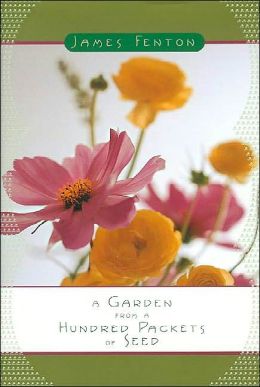
A Garden from a Hundred Packets of Seed by James Fenton, 2001, Farrar, Straus and Giroux, 125 pages.
I remember first seeing the slim silhouette of James Fenton‘s A Garden from a Hundred Packets of Seed at my local library. It was some time ago and back then I was building a city garden from hundreds of packets of seeds here at my house so I just looked beyond its spine to find more encyclopedic picture books.
So yes, because of its size, I didn’t take the book as seriously as I should have, instead I assumed it was a memoir or journal. I’m not throwing shade, it just wasn’t what I thought I was looking for at that exact moment—and I was oh so wrong!
I wish I’d read this book years ago when I first saw it. I’m a seed freak and germination enthusiast after all. Then again, having found it years into my gardening life, it did allow me to sing along with him as he sung the praises of many plants I’m quite familiar with now.
A well-known poet, journalist and literary critic, it just so happens that Fenton is also an avid and accomplished gardener. This book is a collection of columns he was asked to write about the 100 essential plants that he’d pick to populate a garden from seed. Instead of dispassionate know-how and how-to tips, this book is written with great passion—and it’s quite opinionated too. More than anything else, it’s a book that argues for growing plants from packets of seeds. The author doesn’t tell the reader how to use them, or where or when to sow them, but he encourages curiosity and creativity using his own quips and experiences as evidence for their inclusion in any garden.
“The seeds I have chosen are generally speaking ones which have, over several years, given me pleasure in my garden. This is a personal anthology.” (page 12)
Mr. Fenton is not a garden writer. He also does not include himself in the category of “gardening writer” although his book falls into the category of gardening. (Yes, it even says so right there on the back cover.)
I found that he does such a great job of writing about gardening, that he’s sure to upset many readers. There’s nothing I enjoy more as a reader than a well thought out opinion that stirs up some thought on my part:
“Today some makers of gardens are so brow-beaten by color snobbery that they settle for a garden in which all flowers are excluded, or they take nervous care to check which flowers, which colors, are okay. Gardening writers, in the hope of giving the weight of science to their reflections, talk about the combinations of complementary colors, and sometimes even refer to the color wheel. But this is uncandid taste masquerading as high theory.” (page 15)
This book should be on the required reading list of any aspiring garden writer—even if this means that you learn to dislike it because this is a wonderful book to dislike for all of the right reasons—namely the author’s own opinionated voice and the validity of his arguements.
“Among the plants for people who don’t really like plants is the recently popular category called ‘architectural’. What is an architectural plant? It is something big, and possibly expensive and of a bold shape—above all something that promises to make an immediate and permanent impact on the space we are filling—but its resemblance to actual architecture may be minimal. A stand of bamboo does not remind me of any architecture I know, even though I have lived in countries where much of the architecture uses bamboo. And what building looks like a phormium?” (Page 24)
I, for one, enjoyed A Garden from a Hundred Packets of Seed because it’s not formulaic in any sense. Fenton writes in strong stokes, making an ephemeral and vague list. He’s a poet after all and the book will leave an impression. Not all gardening is scientific or botanic and this book succeeds in quenching the thirst of readers like me—call us whatever you will.
James Fenton has since moved on from the large garden he describes in A Garden from a Hundred Packets of Seeds, but it’s clear from this text that the man sees gardens everywhere.
“So my definition—my nondefinition—of a garden must include a spectacular one that I saw last summer in Manhattan, which consisted of nothing but morning glories grown on a fire escape, high up above the street. Mustard and cress sown on a washcloth, Virginia stock in an old crab shell, or a row of hyacinths in glasses—all these count as gardens, in my understanding of the word, along with Great Dixter, Powis Castle, and Versailles.” (pages 6-7)
There is plenty of good in this book and I’m sorry not to include his list of 100 seed packets here because I’d rather you sought the book out yourself. Using it as inspiration, I hope to continue to stock my own garden and seed shop with as many of them as is possible. The list really is a great one—kind of like a much-loved mixed tape from a gardening friend.















